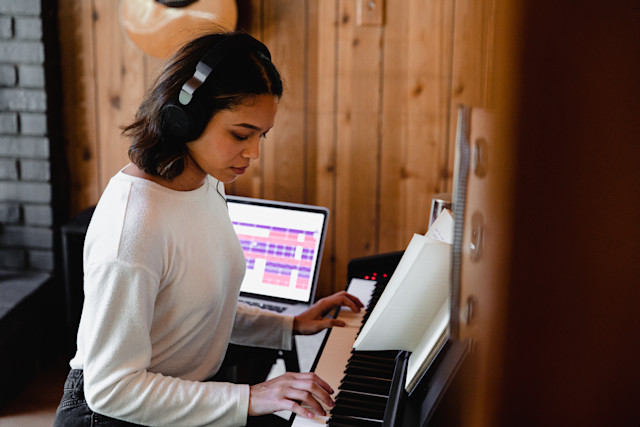How to Write Song Lyrics: Pro Guide for Beginners
January 9, 2024 | Tero Potila

Writing song lyrics is a deeply personal and creative process that blends emotion with storytelling. It's about expressing your thoughts, experiences, and emotions in a way that resonates with others.
There are as many ways to approach lyric writing as there are stories to tell. Whether you're an up-and-coming lyricist or a professional songwriter looking to refine your craft, understanding the fundamentals of how to write song lyrics can take your ideas from simple tunes to memorable musical expressions.
The songwriting process often begins with a spark – a line, a theme, or a melody that tugs at your creativity. Transforming this initial inspiration into a full set of lyrics involves molding your ideas into a structure that listeners can follow and connect with.
When it comes to the song's structure, standards like the ABAB structure (verse, chorus, verse, chorus) are popular today, but there are no strict rules—songwriting is as much an art as it is a science.
It's important to write in a way that's authentic to you, using language that feels natural and sincere. Keep in mind that the most impactful lyrics are those that are relatable and convey genuine emotion.
Read more: How To Write Rap Lyrics Like The GOATs
How to Write Song Lyrics
Lyric writing is a craft that blends the poetic with the musical, where rhythm and melody meet language and imagery. This is true whether you're writing lyrics for rapping or a melody line. The goal is to create a seamless experience between your words and the music; each enhances the other.
Rewriting is also a crucial part of the songwriting process. Even the most experienced songwriters revise their lyrics multiple times to achieve the desired impact.
You can often find ideas for lyrical topics in the most unexpected sources; it could come from your personal experiences or from your circle of friends. Even hearing a conversation between two strangers can spark ideas. TV shows and movies are another great source.
You should keep a diary or notebook for lyrical ideas. Writing down just a couple lines can later spark an idea for a complete song that could become your next big hit. The notes can also help if you're struck with writer's block. Often, all you need is a fresh idea for a good start, and you're on your way again.
The most important thing is to keep writing. Every great songwriter is always working on their craft.
Read more: Songwriter Tips: Overcome Writer’s Block for Good
Getting Started with Lyric Writing
Understanding Song Structure
The starting point for good songs is the common song structure.
Typical Song Structures
Typically, pop songs follow an ABAB or AABAB format where 'A' represents the verse and 'B' signifies the chorus. This foundational blueprint allows you to allocate your lyrics effectively and ensures that your song has a fluid progression that listeners are accustomed to.
The chorus should be your song's lyrical and musical high point, like the top of the mountain. Everything else in the song supports the chorus and leads to it.
Pre-Chorus
Songs often also feature a pre-chorus before the chorus. A pre-chorus is an attachment to the chorus that helps reinforce and lift the chorus. It prepares the listener for the chorus.
Bridge
Modern pop songs sometimes also include a bridge. Its name is very fitting as it connects two sections of the song, usually the last two choruses.
Lyrically, the bridge introduces new information that wasn't yet described in the verses and choruses.
Finding a Good Idea
Your lyrics need a good idea or theme at their core. This is the seed from which your song grows.
Begin by brainstorming experiences, feelings, or messages you feel passionate about. Your opening line or first line is critical — it's the hook that pulls listeners in and should relate directly to your central theme.
Choosing a Song Title
The song title often sets the tone for the entire piece. It’s the flag you plant that represents the territory of your song. Consider making your title catchy, thought-provoking, and reflective of your lyrics.
Often, the first thing that catches a listener's attention is the title, so choose one that resonates with them and the message you’re conveying.

Your lyrics need a good idea or theme at their core. This is the seed from which your song grows.
Developing Your Lyrics
When you're ready to bring your song to life, focus on creating a strong foundation with the first verse and building momentum through the chorus and second verse before leaving a lasting impression with the final line.
Crafting the First Verse
Your first verse is the opening act of your song's story, setting the scene for your listeners. Here's how to start strong:
Set the Tone: Consider the mood and establish the theme of your song.
Introduce the Narrative: Provide listeners with the context to follow the rest of the song.
Creating Memorable Choruses
The chorus is the heart of your song and often the most memorable part. Aim for these qualities:
Catchiness: Use a simple, repeatable melody that listeners can easily remember.
Emotional Hook: Inject emotion to make the chorus resonate with the audience.
Building the Second Verse
The second verse should deepen the story introduced in the first verse and lead seamlessly back to the second chorus.
Continue the Tale: Reflect on your song's message or storyline progression.
New Information: Give the audience more details or a twist to maintain interest.
Concluding with the Last Line
The last line is your closing statement; it's your chance to leave a powerful impression.
Summarize the Theme: Try to encapsulate the essence of the song in a poignant way.
Echo the Message: Reiterate or complement the song's central message for impact.
Enhancing Your Lyrics
Incorporating Rhyme Schemes
To create a sense of cohesiveness in your lyrics, rhyme schemes are essential. Perfect rhymes create a satisfying harmony, while internal rhymes within lines add a layer of sophistication.
Consider these common schemes:
AA/BB: Consecutive lines rhyme.
ABAB: Alternate lines rhyme, which provides a balanced flow.
XAXA: Every second line rhymes, allowing for creative freedom with unrhymed lines.
Experiment with schemes to find what best complements your song's tone and rhythm.
Using Action Words and Imagery
Energize your lyrics by using action words that propel the narrative forward. Vivid imagery allows listeners to visualize the story, making your words more impactful. For example:
Instead of "I felt sad," try "The tears streamed down, carving rivers in my cheeks."
Use metaphors to strengthen a line: "Your words are a thunderstorm, electrifying the night."
Include sensory details that resonate with your audience, inviting them to experience the song rather than just hear it.
Applying Melody and Chord Progressions
The melody and chord progressions can elevate your lyrics from good to incredible. Start by building a simple progression that complements the emotion behind your lyrics:
Upbeat tempos pair well with uplifting chord progressions.
Minor chords add depth to somber themes.
Meld your lyrics with the ebb and flow of the melody to create a powerful musical narrative that captures your listener's attention.
Polishing and Completing Your Song
Editing for Better Lyrics
Your first draft is just the beginning. Now, it's time to take a closer look and edit your work for clarity, emotion, and impact. Go through your lyrics line by line, asking yourself:
Does each line contribute to the overall message?
Can I replace clichés with more original phrases?
Is there a strong mix of showing and telling?
Make a checklist with these questions to systematically review your lyrics, ensuring they're the best they can be.
Remember that the listener will only know the information you provide in the lyrics. When reviewing your lyrics, make sure you are giving them enough details to understand the whole story.
Feedback and Revisions
Once you've edited your lyrics, seek out feedback from trusted friends, fellow musicians, or mentors. Their fresh ears can catch things you might have missed and offer new perspectives on how to improve.
Keep an open mind to the feedback you receive, and remember:
Not all feedback will be useful—filter through and decide what resonates with your vision.
Use the comments you agree with to guide further revisions of your lyrics.
Prioritize constructive criticism that aligns with your goals for the song to ensure your own lyrics truly resonate as good song lyrics.
Conclusion
We've covered all the basics of how to write song lyrics.
There are as many different ways of writing powerful lyrics as there are songwriters! Songwriting is a personal art form that weaves emotion and storytelling.
Mastering the fundamentals of lyric writing can transform compositions into memorable expressions. Great song lyrics often start with a simple idea, and the best songs feature a familiar concept or story told in a unique, different way.
Always keep in mind that authenticity is key when it comes to creating memorable lyrics.
Understanding song structure, central themes, and impactful titles are all important concepts to understand, and rhyme schemes, vivid imagery, and melody all help enhance lyrics and add emotion.
Crafting strong foundations with the first verse, building momentum through choruses and second verses, and concluding with a powerful last line are the building blocks of great lyrics.
It's also important to work on your lyrical ideas on a regular basis. Practice helps strengthen your craft, and it becomes easier and easier to develop great ideas.
About the author
Tero Potila is a professional music composer and producer. His career combining knowledge and experience from music, TV, film, ad, and game industries gives him a unique perspective that he shares through posts on teropotila.com.
Get started with Soundtrap today!